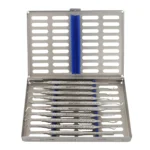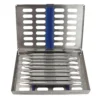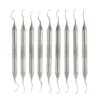GDC Gracey Curettes S/9 (10mm) Instruments Kit (GCWC9)
Original price was: ₹19,950.00.₹12,860.00Current price is: ₹12,860.00.
Set of 9 Gracey Curette:
- 1 x SG1/2 #6
- 1 x SG3/4 #6
- 1 x SG5/6 #6
- 1 x SG7/8 #6
- 1 x SG9/10 #6
- 1 x SG11/12 #6
- 1 x SG13/14 #6
- 1 x SG15/16 #6
- 1 x SG17/18 #6
Description
Specially for subgingival scaling and root planning
- Generally speaking, the higher the curette tip number, the further back in the mouth it is used.
- The Gracey 1/2 is designed for use on all aspects of anterior teeth (including canines). The instrument has a small contra-angle and a return angle resulting in an instrument toe that is close to the mid-line of the instrument handle for better stability. The shank is particularly long on Gracey 1/2s to permit access to lower anteriors with the patient in a supine position.
- The Gracey 3/4 is also designed for use on all aspects of anteriors, but this time as far back as the second bicuspid.
- Gracey 5/6s are best used interproximally on most teeth up to and including the second molars, and distally and lingually up to the second bicuspid. However, the instrument’s angulation means access to difficult areas and posteriors is limited.
- A Gracey 7/8 is arguably the most versatile in the range and can be used on the buccal and lingual surfaces of bicuspids and molars. The instrument has a large contra-angle with only a medium return angle and a shorter shank than the previously described curettes. The tip terminates in a hooked toe standing off-line to the instrument to allow for any tendency to twist during use to be countered by the angle of insertion.
- The remainder of the Gracey range is designed to root plane the posterior teeth, with a bias towards the molars. These patterns are specifically adapted to the complex root anatomy found in this region. The Gracey 9/10 is predominantly used on the buccal and lingual molar aspects, especially around the bifurcation, where access can be difficult. Its wide contra-angle, wide return angle, and short shank make for a distinctive instrument. The toe is very nearly in line with the instrument handle, making this pattern especially suited to the least accessible root surfaces, while still allowing good control.
- The 11/12 and the 13/14 Graceys act as a pair, permitting access to the mesial and buccal root surfaces respectively. These Gracey’s are suited for use on both bicuspids and molars. The small contra-angle and return angle are complemented by a third angle to offset the blade, which forms a smooth bladed toe. This third angle is exaggerated on the 13/14 to curl the toe round further. These curettes’ tips are notably long, permitting access to the posterior teeth while keeping the clinician’s hand comfortably out of the mouth.
- The last pair of Graceys, the 15/16 and 17/18, are likely to be new. To solve problems hygienists had reported access to particularly awkward spaces. They allow improved access mesially (the 15/16) and distally (the 17/18) to areas that even the complex curvature of the 11/12 and 13/14 has proved unable to reach satisfactorily. The 15/16 has the same exaggerated terminal shank design as the 13/14, but the blade is finished like an 11/12. This exaggerated angle helps correct positioning on harder-to-reach mesial molar surfaces. The 17/18 also has the same extreme angle, but also a longer terminal shank and reduced blade length to improve access to the distal surfaces of posterior teeth. With such a comprehensive choice available, many clinicians will favour a small selection for everyday use with the remainder of the range on “stand-by” to deal with more unusual cases. It’s reassuring to know there are tools in the cabinet to comfortably manage every type of clinical situation.
Only logged in customers who have purchased this product may leave a review.











Reviews
There are no reviews yet.